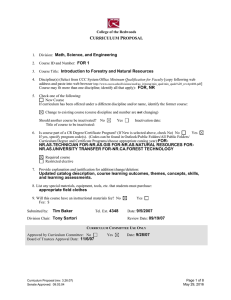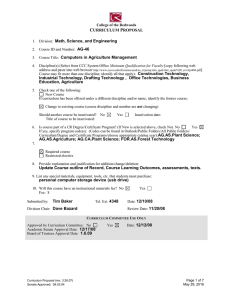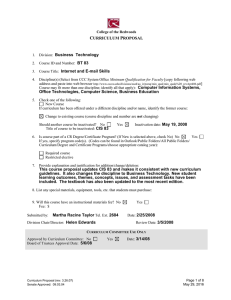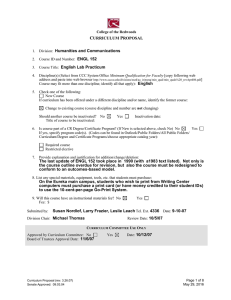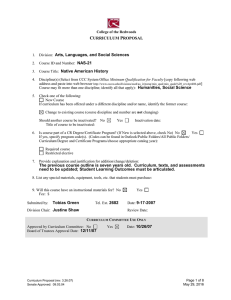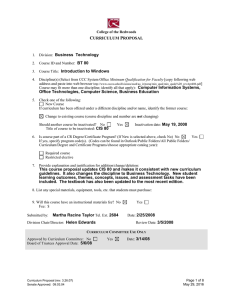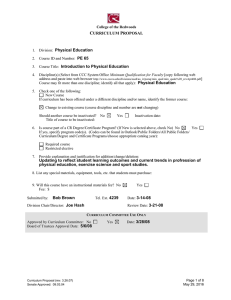C P
advertisement
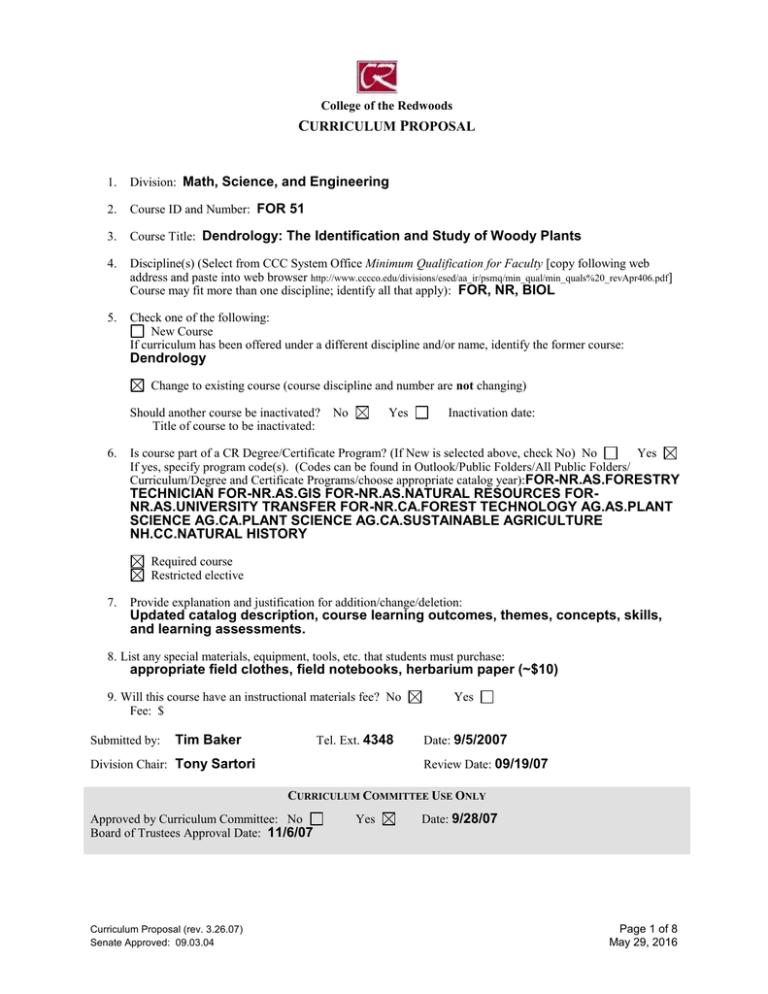
College of the Redwoods CURRICULUM PROPOSAL 1. Division: Math, Science, and Engineering 2. Course ID and Number: FOR 51 3. Course Title: Dendrology: The Identification and Study of Woody Plants 4. Discipline(s) (Select from CCC System Office Minimum Qualification for Faculty [copy following web address and paste into web browser http://www.cccco.edu/divisions/esed/aa_ir/psmq/min_qual/min_quals%20_revApr406.pdf] Course may fit more than one discipline; identify all that apply): FOR, NR, BIOL 5. Check one of the following: New Course If curriculum has been offered under a different discipline and/or name, identify the former course: Dendrology Change to existing course (course discipline and number are not changing) Should another course be inactivated? Title of course to be inactivated: 6. No Yes Inactivation date: Is course part of a CR Degree/Certificate Program? (If New is selected above, check No) No Yes If yes, specify program code(s). (Codes can be found in Outlook/Public Folders/All Public Folders/ Curriculum/Degree and Certificate Programs/choose appropriate catalog year):FOR-NR.AS.FORESTRY TECHNICIAN FOR-NR.AS.GIS FOR-NR.AS.NATURAL RESOURCES FORNR.AS.UNIVERSITY TRANSFER FOR-NR.CA.FOREST TECHNOLOGY AG.AS.PLANT SCIENCE AG.CA.PLANT SCIENCE AG.CA.SUSTAINABLE AGRICULTURE NH.CC.NATURAL HISTORY Required course Restricted elective 7. Provide explanation and justification for addition/change/deletion: Updated catalog description, course learning outcomes, themes, concepts, skills, and learning assessments. 8. List any special materials, equipment, tools, etc. that students must purchase: appropriate field clothes, field notebooks, herbarium paper (~$10) 9. Will this course have an instructional materials fee? No Fee: $ Submitted by: Tim Baker Tel. Ext. 4348 Division Chair: Tony Sartori Yes Date: 9/5/2007 Review Date: 09/19/07 CURRICULUM COMMITTEE USE ONLY Approved by Curriculum Committee: No Board of Trustees Approval Date: 11/6/07 Curriculum Proposal (rev. 3.26.07) Senate Approved: 09.03.04 Yes Date: 9/28/07 Page 1 of 8 May 29, 2016 SUMMARY OF CURRICULUM CHANGES FOR AN EXISTING COURSE FEATURES Catalog Description (Please include complete text of old and new catalog descriptions.) Grading Standard OLD NEW The study of forest plant identification, taxonomy and classification. Forest habitats, ecotypes, plant associations, and forest vegetation types will be discussed, emphasizing those widespread in the Pascific Northwest. Botanical characteristics, commersional and non-commercial uses and ranges of selected forest species are covered The identification, naming and classification of woody plants that occur in regional forest communities. Class discussions will cover the technical language and processes of plant taxonomy and nomenclature as well as botanical and ecological characteristics of various forest species. Discussions will also include forest species found outside the region that are important economically or ecologically. Select Select Total Units Lecture Units Lab Units Prerequisites Corequisites Recommended Preparation Maximum Class Size 25 Repeatability— Maximum Enrollments Other Course learning outcomes, course content, learning assessments If any of the listed features have been modified in the new proposal, indicate the “old” (current) information and proposed changes. Curriculum Proposal (rev. 3.26.07) Senate Approved: 09.03.04 Page 2 of 8 May 29, 2016 College of the Redwoods COURSE OUTLINE DATE: 9/5/2007 COURSE ID AND NUMBER: FOR 51 COURSE TITLE: Dendrology: the identification and study of woody plants FIRST TERM NEW OR REVISED COURSE MAY BE OFFERED: Spring 2008 TOTAL UNITS: 3 TOTAL HOURS: 90 [Lecture Units: 2 [Lecture Hours: 36 Lab Units: 1] Lab Hours: 54] MAXIMUM CLASS SIZE: 25 GRADING STANDARD Letter Grade Only CR/NC Only Is this course repeatable for additional credit units: No Grade-CR/NC Option Yes If yes, how many total enrollments? Is this course to be offered as part of the Honors Program? No Yes If yes, explain how honors sections of the course are different from standard sections. CATALOG DESCRIPTION The catalog description should clearly state the scope of the course, its level, and what kinds of student goals the course is designed to fulfill. The identification, naming and classification of woody plants that occur in regional forest communities. Class discussions will cover the technical language and processes of plant taxonomy and nomenclature as well as botanical and ecological characteristics of various forest species. Discussions will also include forest species found outside the region that are important economically or ecologically. Special notes or advisories: Field trips are required; the College does not provide transportation PREREQUISITES No Yes Course(s): Rationale for Prerequisite: Describe representative skills without which the student would be highly unlikely to succeed . COREQUISITES No Yes Rationale for Corequisite: Curriculum Proposal (rev. 3.26.07) Senate Approved: 09.03.04 Course(s): Page 3 of 8 May 29, 2016 RECOMMENDED PREPARATION No Yes Course(s): Rationale for Recommended Preparation: COURSE LEARNING OUTCOMES What should the student be able to do as a result of taking this course? State some of the objectives in terms of specific, measurable student accomplishments. 1. 2. 3. 4. 5. Be able to explain the system of classification used by plant taxonomists Identify various woody plants and correctly assign scientific names and classification. Identify and name the various parts of woody plants. Be able to use the technical language of plant taxonomy. Correctly nagivate and use a dichotomous key. COURSE CONTENT Themes: What themes, if any, are threaded throughout the learning experiences in this course? Variability within and between species and the effect this has on classification. Concepts: What concepts do students need to understand to demonstrate course outcomes? 1. The basic premise of evolution and natural selection as it applies to phylogenetic classification systems. 2. The concept that a suite of botanical characteristics are used to identify to a single species. Issues: What primary issues or problems, if any, must students understand to achieve course outcomes (including such issues as gender, diversity, multi-culturalism, and class)? Skills: What skills must students master to demonstrate course outcomes? 1. Visual discrimination necessary to identify various forest species in a variety of contexts. 2. Recall and correctly spell the scientific nomenclature associated with each species. 3. Develop and use dichotomous keys in identifying plants. REPRESENTATIVE LEARNING ACTIVITIES What will students be doing (e.g., listening to lectures, participating in discussions and/or group activities, attending a field trip)? Relate the activities directly to the Course Learning Outcomes. 1. Listen to lectures and participate in discussions about the foundations of plant taxonomy. 2. Participate in small-group learning exercises in developing and using dichotomous keys. 3. Attend field trips where the identification of various species is demonstrated. ASSESSMENT TASKS How will students show evidence of achieving the Course Learning Outcomes? Indicate which assessments (if any) are required for all sections. Representative assessment tasks: 1. Field identification quizzes. 2. Lecture quizzes on plant taxonomy, morphology and ecological characteristics. 3. Plant collection with dichotomous key. 4. Weekly 'unknowns'. Curriculum Proposal (rev. 3.26.07) Senate Approved: 09.03.04 Page 4 of 8 May 29, 2016 Required assessments for all sections – to include but not limited to: Field identification quizzes including a comprehensive final lab/field practical exam. EXAMPLES OF APPROPRIATE TEXTS OR OTHER READINGS Author, Title, and Date Fields are required Author Hardin, Leopold and White Author Stuart and Sawyer Author Title Date Author Title Date Title Title Textbook of Dendrology Trees and Shrubs of California Date Date 2001 2001 Other Appropriate Readings: Woody Plant ID CD-Rom Curriculum Proposal (rev. 3.26.07) Senate Approved: 09.03.04 Page 5 of 8 May 29, 2016 PROPOSED TRANSFERABILITY: CSU UC If CSU transferability is proposed (courses numbered 1-99), indicate whether general elective credit or specific course equivalent credit is proposed. If specific course equivalent credit is proposed, give course numbers/ titles of at least two comparable lower division courses from a UC, CSU, or equivalent institution. None General elective credit Specific course equivalent 1. , (Campus) 2. , (Campus) CURRENTLY APPROVED GENERAL EDUCATION CR CSU IGETC CR GE Category: CSU GE Category: IGETC Category: PROPOSED CR GENERAL EDUCATION Rationale for CR General Education approval (including category designation): Natural Science Social Science Humanities Language and Rationality Writing Oral Communications Analytical Thinking PROPOSED CSU GENERAL EDUCATION BREADTH (CSU GE) A. Communications and Critical Thinking A1 – Oral Communication A2 – Written Communication A3 – Critical Thinking C. Arts, Literature, Philosophy, and Foreign Language C1 – Arts (Art, Dance, Music, Theater) C2 – Humanities (Literature, Philosophy, Foreign Language) E. Lifelong Understanding and SelfDevelopment E1 – Lifelong Understanding E2 – Self-Development B. Science and Math B1 – Physical Science B2 – Life Science B3 – Laboratory Activity B4 – Mathematics/Quantitative Reasoning D. Social, Political, and Economic Institutions D0 – Sociology and Criminology D1 – Anthropology and Archeology D2 – Economics D3 – Ethnic Studies D5 – Geography D6 – History D7 – Interdisciplinary Social or Behavioral Science D8 – Political Science, Government and Legal Institutions D9 – Psychology Rationale for inclusion in this General Education category: Same as above Curriculum Proposal (rev. 3.26.07) Senate Approved: 09.03.04 Page 6 of 8 May 29, 2016 Proposed Intersegmental General Education Transfer Curriculum (IGETC) 1A – English Composition 1B – Critical Thinking-English Composition 1C – Oral Communication (CSU requirement only) 2A – Math 3A – Arts 3B – Humanities 4A – Anthropology and Archaeology 4B – Economics 4E – Geography 4F – History 4G – Interdisciplinary, Social & Behavioral Sciences 4H – Political Science, Government & Legal Institutions 4I – Psychology 4J – Sociology & Criminology 5A – Physical Science 5B – Biological Science 6A – Languages Other Than English Rationale for inclusion in this General Education category: Curriculum Proposal (rev. 3.26.07) Senate Approved: 09.03.04 Same as above Page 7 of 8 May 29, 2016 FOR VPAA USE ONLY PROGRAM AND COURSE NUMBER FOR-51 TECHNICAL INFORMATION 1. Department: SCI Science 16. CoRequisite Course: None 2. Subject: Forestry 17. Recommended Prep: None Course No: 51 3. Credit Type: D Credit Degree Applicable 18. Maximum Class Size: 25 4. Min/Maximum Units: 3.0 to 19. Repeat/Retake: NR No repeats variable units 5. Course Level: D Possibly Occupational 20. Count Retakes for Credit: yes no 6. Academic Level: UG Undergraduate 21. Only Pass/No Pass: yes no 7. Grade Scheme: UG Undergraduate 22. Allow Pass/No Pass: yes no 8. Short Title: Dendrology: Idnt/Woody Plants 23. VATEA Funded Course: yes no 9. Long Title: Dendrology: the Identification and 24. Accounting Method: W Weekly Census Study 25. Disability Status: N Not a Special Class 10. National ID (CIP): 03.0501 26. Billing Method: T-Term 11. Local ID (TOPS): 011400 27. Billing Period: R-Reporting Term 12. Course Types: Level One Basic Skills: NBS Not Basic Skills Level Two Work Experience: 28. Billing Credits: 3.0 29. Purpose: I Occupational Ed NWE Not Coop Work Experience 30. Articulation No. Level Three: (CAN): Placeholder for GE OR 31. Articulation Seq. (CAN): DOES NOT APPLY 32. Transfer Status: B Transfers to CSU only Level Four: If GE : Choose One: 33. Equates to another course? (course number). 13. Instructional Method: LL Lecture/Lab 14. Lec TLUs: 3.0 Contact Hours: 36 Lab TLUs: 3.0 Contact Hours: 54 Lecture/Lab TLUs: 6.0 Contact Hours: 90 34. The addition of this course will inactive number). Inactive at end of term. 15. Prerequisite: None Particular Comments for Printed Catalog. . Curriculum Approval Date: 9/28/07 Curriculum Proposal (rev. 3.26.07) Senate Approved: 09.03.04 Page 8 of 8 May 29, 2016 (course
